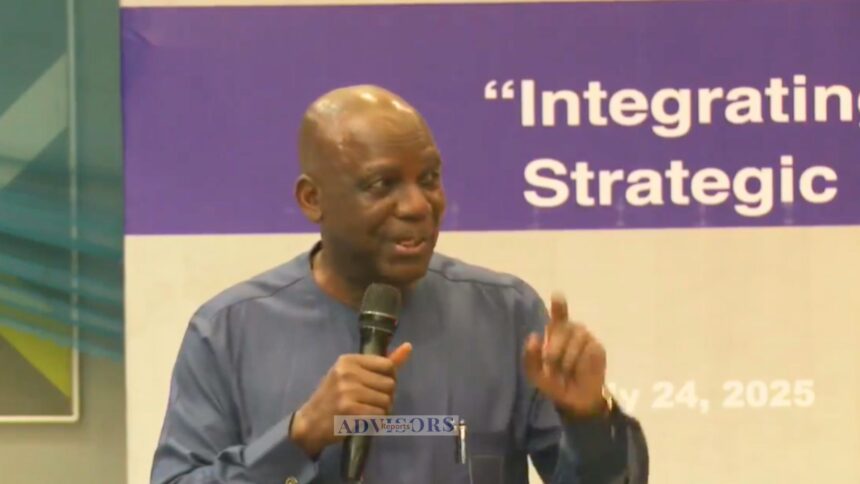… urges NMDPRA to reconcile regulated gas price with market rate
... says- “If GenCos can’t recover expenses for operations, maintenance, there will be recurring power system failures”
Oredola Adeola
Professor Barth Nnaji, Chairman of Geometric Power, has urged the Nigerian Midstream and Downstream Petroleum Regulatory Authority (NMDPRA) to reconcile the gap between the regulated $2.42 per MMBTU domestic gas price for power generation and the prevailing market rate of $2.70 to $9/MMBTU.
He recommended a more realistic tariff framework that aligns with actual gas procurement costs for electricity Generation Companies (GenCos).
He made this known in his opening remark at the Orient News Nigeria 2025 Conference on Thursday, in Lagos.
Nnaji noted that while the official domestic gas price for power generation was formerly pegged at $2.42 per MMBtu, the NMDPRA revised this down to $2.13/MMBtu effective April 1, 2025.
However, in reality, GenCos often source gas from the open market where prices range from $2.70 to as high as $9/MMBtu, depending on supply constraints and contract terms.
“Because most electricity is generated using gas, and GenCos depend heavily on sourcing this gas from the open market, the disparity between the regulated and actual prices continues to strain the sector,” Nnaji said.
He warned that the pricing gap is worsening liquidity challenges in the power sector, contributing significantly to the ₦1.1 trillion electricity subsidy recorded in the first half of 2025 and the growing trillion-naira debt owed to GenCos by the federal government.
According to him, “The gas-to-power benchmark being below market realities places an unsustainable burden on power producers.”
He also emphasized the need for more cost-reflective electricity tariffs, explaining that the current pricing structure fails to cover the operational and maintenance costs of GenCos, particularly as many critical inputs are imported.
“The energy charge component of the power tariff must be able to cover the cost of maintaining the assets.
“If operators can’t recover expenses for operations and maintenance, which are often dollar-denominated, there will be recurring power system failures,” Nnaji said.
“The regulator must continue to adjust the tariff in line with actual industry costs to ensure sustainability.”
Prof. Barth Nnaji, while commenting on the topic of the conference: “Integrating Nigeria’s Gas Potential into Strategic Energy Transition Initiatives”, expressed deep concern over Nigeria’s inability to fully harness its vast natural gas reserves for electricity generation, despite having over 200 trillion cubic feet (Tcf) of proven reserves.
Nnaji said, “It’s quite perplexing. We are a gas-rich country, yet we struggle to supply enough gas to our power plants.
” NLNG, with its Train-7, is not operating at full capacity due to feed gas constraints. It’s a contradiction that many find hard to understand,” he said.
He further emphasised that while Nigeria previously exported coal and had a functioning mining industry, the country abruptly abandoned these alternatives without adequate transition planning.
Speaking on the future of Nigeria’s energy mix, Nnaji said that while hydro and solar power have a role to play, gas-fired power plants will remain the dominant source of electricity for the next one to two decades.
“Hydro power has its limits in Nigeria due to seasonal variability and geopolitical concerns, particularly as it depends on stable relationships with northern communities and neighbouring countries,” he said.
He further emphasized that Nigeria is not investing adequately in gas production and pipeline transportation infrastructure, calling for greater private sector involvement.
“Nigeria has all the capacity it needs. Government should remain an enabler, but the private sector must take the lead.
“If we don’t produce enough gas, even promising initiatives like CNG adoption will not take off,” he warned.
Prof. Nnaji further noted that most gas-fired power plants in Nigeria suffer from erratic operations due to inconsistent gas pressure and supply, an unacceptable situation for a nation with abundant gas resources.
He argued that with sufficient gas supply, Nigeria could stabilize its economy and expand into industrial processing such as petrochemicals, creating a diversified energy ecosystem.
Commenting on the plan by the MainPower Electricity Distribution Ltd to charge Band A customers N160 per kilowatt-hour, down from the previous N209, following a directive by the Enugu State Electricity Regulatory Commission (EERC), effective 1 August 2025, Nnaji cautioned that states must be financially prepared to bear the burden of subsidy, if they are to manage electricity supply effectively.
He warned that once states take over electricity regulation and distribution under the Electricity Act, they must be ready to subsidize electricity directly or risk service breakdowns.
He questioned assumptions behind the current tariff framework, where DisCos are expected to supply power to consumers at ₦45/kWh, based on a presumed federal subsidy through NBET to GenCos.
“There’s a belief that the federal government subsidizes power purchases, but in reality, that subsidy isn’t always there. This has contributed to the over ₦5.2 trillion debt owed to GenCos,” he said.
Nnaji also raised concerns about the contentious application of ATC&C losses (Aggregate Technical, Commercial, and Collection losses), which influence cost-reflective tariffs and remittance obligations.
“The ATC&C losses used to be an average of 25 and 27 percent, but very few DisCos operates at that.”
“Most of the DisCos remit as little as 30 percent of the power they receive, while others remit up to 60 percent of the value of the power that they purchased Minimum Remittance Obligations (MRO) tied to their efficiencies. These discrepancies affect liquidity across the market,” he noted.
He stressed the need for enforceable Power Purchase Agreements (PPAs) and the resolution of issues like vandalism and operational disruptions that hinder gas supply and power offtake.
“Without a consistent gas supply and proper market design, we can’t expect PPAs to deliver,” he said.




